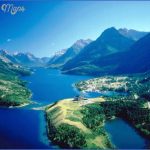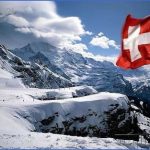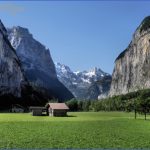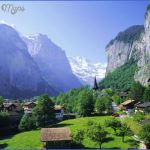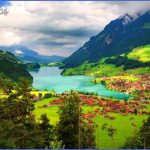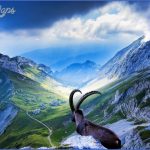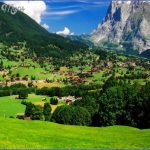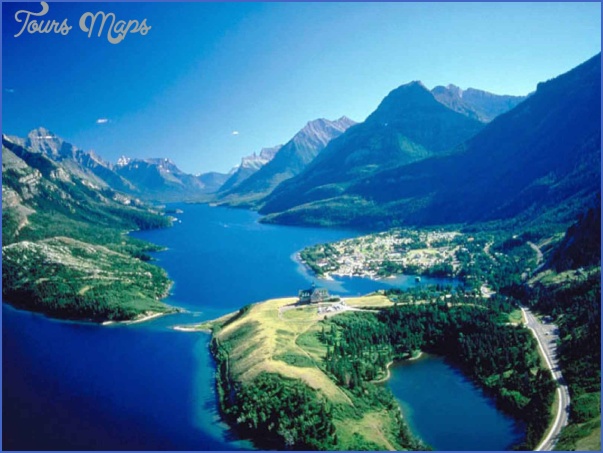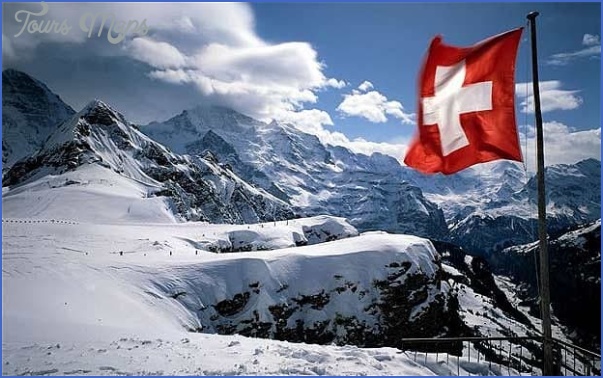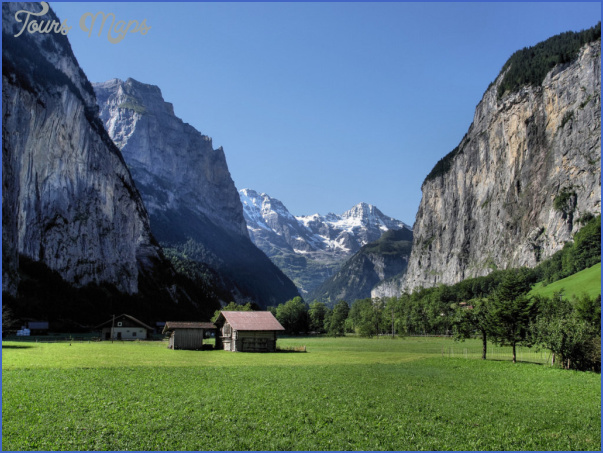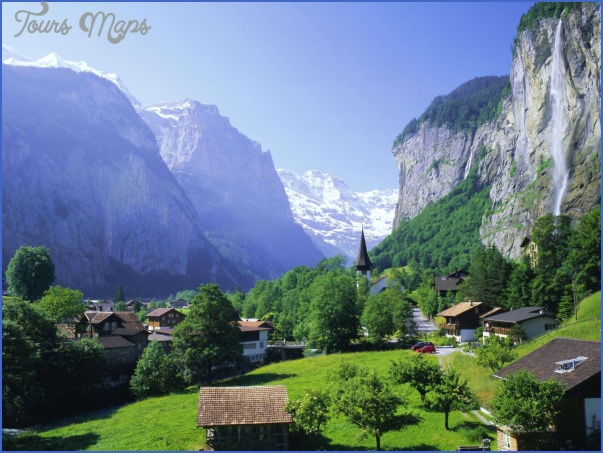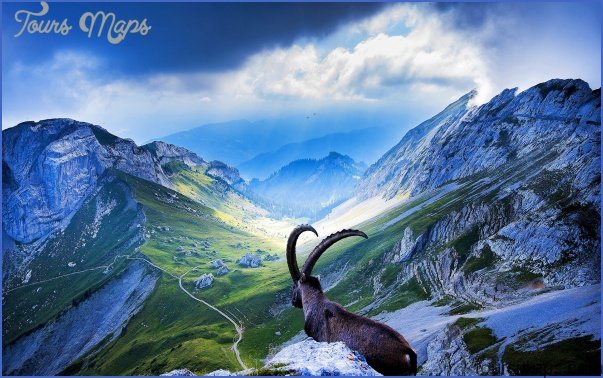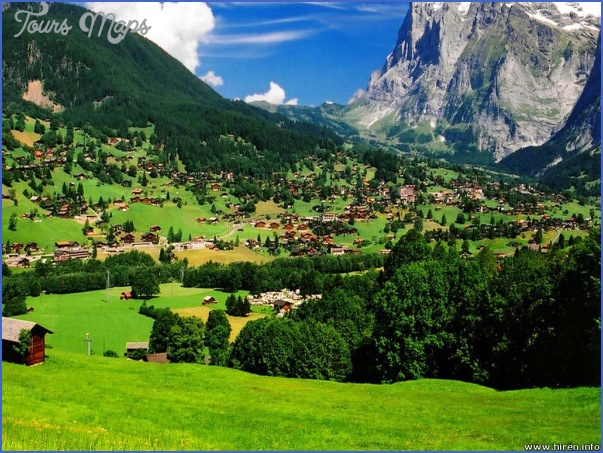SWITZERLAND
(SCHWEIZ, SUISSE, SVIZZERA)
The unparalleled natural beauty of Switzerland entices outdoor enthusiasts from around the globe to romp in its Alpine playground. Three-fifths of the country is dominated by mountains: The Jura cover the northwest region bordering France, the Alps stretch gracefully across the entire lower half of Switzerland, and the eastern Rhaetian Alps border Austria. While the stereotypes of Switzerland as a Big Money banking and watch-making mecca are to some extent true, its energetic youth culture belies its staid reputation. Although the country is not known for being cheap, the best things warm Swiss hospitality and the highest peaks in Europe remain priceless.
AGAINST THE EMPIRE (500-1520). Switzerland had been loosely united since 1032 as part of the Holy Roman Empire, but when Emperor Rudolf of Habsburg tried to assert control over their land in the late 13th century, the Swiss decided to rebel. Three of the Alemanni communities (the Forest Cantons) signed an Everlasting Alliance in 1291, agreeing to defend each other from outside attack. The Swiss consider this moment to be the beginning of the Swiss Confederation. However, a union of such fiercely independent and culturally distinct states made for an uneasy marriage. The Swabian War (1499-1500) against the empire brought virtual independence from the Habsburgs, but domestic struggles based on cultural and religious differences continued.
THREE DAY Sffferience the great outdoors at Interlaken 11 Bay, 984),. and ‘ then head to lucetKe.0 day, 973) for the perfect combination of city culture and natural splendor before jetting to international Geneva (1 day, 987).
ONE WEEK Begin in Lucerne (1 day), where your vision of a typical Swiss city will, strangely, be all too true. Then head to the capital, Bern (1 day, 968), before getting your adventure thrills in Interlaken (1 day). Get a taste of Italian Switzerland in Locarno (1 day, 996), then traverse northern Italy to reach Zer-
End your trip in the cosmopolitan city of Geneva (2 days).
TWO WEEKS Start in Geneva (2 days), then check out Lausanne (1 day, 993) and Montreux (1 day, 994). Tackle the Matterhorn in Zermatt (1 day) and keep hiking above Interlaken (1 day). Bask in Locarno’s Mediterranean climate (1 day) then explore the Swiss National Park (1 day, 984). Head to Zurich (2 days, 974) and nearby Lucerne (1 day). Unwind in tiny, romantic Stein am Rhein (2 day, 981) and then return to civilization via the capital, Bern (1 day).
REFORMATION TO REVOLUTION (1520-1800). With no strong central government to settle quibbles between cantons of different religious faith, the Swiss were split even further by the Protestant Reformation. Lutheran Ulrich Zwingli of Zurich and John Calvin of Geneva instituted reforms, but the rural cantons remained loyal to the Catholic faith. When religious differences between the Protestant city cantons and the Catholic rural cantons escalated into full-fledged battle in the mid-16th century, the Confederation intervened, granting Protestants freedom but prohibiting them from imposing their faith on others. The Confederation remained neutral during the Thirty Years’ War, escaping the devastation wrought on the rest of Europe. The Peace of Westphalia, which ended the war in 1648, granted the Swiss independence from the empire. However, Swiss independence was short lived: Napoleon invaded in 1798 and established the Helvetic Republic. After Napoleon’s defeat at Waterloo in 1815, Swiss neutrality was again officially recognized.
NEUTRALITY AND DIPLOMACY (1815 TO THE 20TH CENTURY). With neutrality established by the Treaty of Vienna in 1815, Switzerland could turn its attention to domestic issues. Industrial growth brought relative material prosperity, but religious differences continued to create tension between Catholic and all other cantons. A civil war broke out in 1847, but it lasted only 25 days. The Protestant forces were victorious, and the country wrote a new constitution modeled after that of the United States. Once stabilized, Switzerland cultivated its reputation for resolving international conflicts. The Geneva Convention of 1864 established international laws for conduct during war, and Geneva became the headquarters for the International Red Cross (see 992).
Switzerland’s neutrality was tested in World War I as French- and German-speak-ing Switzerland claimed different cultural loyalties. In 1920, the Allies chose Geneva as the headquarters of the League of Nations, solidifying Switzerland’s reputation as the center for international mediation. During World War II, both sides respected Switzerland (and its banks) as neutral territory. As the rest of Europe cleaned the rubble of two global wars, it nurtured its already sturdy economy; Zurich emerged as a banking and insurance center. Although Geneva became the world’s most prominent diplomatic headquarters, Switzerland remained isolationist in its relations with the rest of Europe, declining membership in the United Nations (until 2002), NATO, and the European Economic Community.
TODAY
Switzerland has become increasingly wealthy, liberal, and successful since WWII and is still fiercely independent and wary of entanglement with the rest of Europe. The Swiss are remarkably progressive in many areas, electing Ruth Dreifuss as their first female president and maintaining one of the world’s most stringent ecological policies to protect their fragile Alpine environment. In the past few years, Swiss banks have come under scrutiny for their blind account policy, which allowed Holocaust victims and Nazi leaders alike to deposit money and gold during WWII.
In the Swiss government, the 26 cantons are incorporated into the Confederation and its two-chamber legislature, the Federal Assembly. The executive branch consists of a group of seven members the Bundesrat (Federal Council) elected to four-year terms. The Bundesrat chooses a president from among its ranks. The president holds office for one year; the post is more symbolic than functional. Frequent referenda and initiatives make political decisions a part of daily life.
THE ARTS LITERATURE
Jean-Jacques Rousseau, best known for his Social Contract (1762), which inspired the French Revolution, was bom in Geneva in 1712 and was always proud of his Swiss background despite the fact that he spent most of his time outside the country and that the Swiss burned his books. When Romanticism caught on in Switzerland, J.J. Bodmer and J.J. Breitinger advocated literature in the Swiss-German language, and Gottfried Keller penned the Bildungsroman (coming-of-age novel) Green Henry (1855). Conrad Ferdinand Meyer was a highly influential Swiss poet whose writings united characteristics of Romanticism and Realism.
Carl iung, whose psychiatric practice in Zurich informed his famous Symbols of Transformation (1916), is considered to be the founder of analytical psychology. Switzerland has also produced several respected modem playwrights: Critics laud Max Frisch for his Brechtian style and thoughtful treatment of Nazi Germany in works such as Andorra (1961), and Friedrich Diirrenmatt won renown for his tragi-comedic portrayal of human corruptibility in The Physicists (1962).
THE VISUAL ARTS
Since the early 20th century, Switzerland has been a prime space for artistic experimentation. One of Switzerland’s most famous painters is Paul Klee, whose delicately colored watercolors and oil paintings helped shape the beginnings of abstraction, questioning dominant modes of artistic expression. In 1916, Zurich became the birthplace of the Dada movement, which rejected traditional aesthetic ideals and attempted to make people reconsider their social values. Later, the country continued to attract liberal artistic thinkers. Switzerland maintains a lively arts scene today; for a glimpse, see Zurich’s Kunsthaus, 980.
FACTS AND FIGURES
Official Name: Swiss Confederation. Land Area: 41,290 sq. km.
Capital: Bern. Time Zone: GMT + 1.
Major Cities: Basel, Geneva, Zurich. Languages: German, French, Italian.
Population: 7,300,000 (65% German, Religions: Roman Catholic (46%), Prot-18% French, 10% Italian). estant (40%), unaffiliated
WHEN TO GO
November to March is ski season; prices in eastern Switzerland double and travelers need reservations months in advance. The situation is reversed in the summer, when the flatter, western half of Switzerland fills up. Sights and accommodations are cheaper and less crowded in the shoulder season (May-June and Sept.-Oct.); call ahead to check if the Alpine resort areas will be open then.
DOCUMENTS AND FORMALITIES
VISAS. EU citizens do not need a visa. Citizens of Australia, Canada, New Zealand, South Africa, and the US do not need a visa for stays of up to 90 days.
EMBASSIES. Most foreign embassies are in Bern (968). Swiss embassies at home include: Australia, 7 Melbourne Ave. Forrest, Canberra, ACT 2603 ( (02) 61 62 84 00); Canada, 5 Marlborough Ave. Ottawa, ON KIN 8E6 (613-235-1837); Ireland, 6 Ailesbury Rd. Ballsbridge, Dublin 4 ( (353) 12 18 63 82); New Zealand, 22 Panama St. Wellington 6001 ((04) 472 15 93); South Africa, P818 George Ave. Arcadia 0083, 0001 Pretoria ((012) 430 67 07); UK, 16-18 Montagu PL, London W1H 2BQ ((020) 76 16 60 00); and US, 2900 Cathedral Ave. NW, Washington, D.C. 20008 (202-745-7900).
TRANSPORTATION
BY PLANE. Major international airports for overseas connections are in Bern (BRN), Geneva (GVA), and Zurich (ZRH). From the UK, easyJet ((0870) 600 00 00; www.easyjet.com) has flights from London to Geneva and Zurich (UK&47-136). From Ireland, Aer Lingus ((01) 886 32 00; www.aerlingus.ie) sells round-trip tickets from Dublin to Geneva for ‚100-300.
BY TRAIN. Federal (SBB, CFF) and private railways connect most towns, with frequent trains. For times and prices, check online (www.sbb.ch). Eurail, Euro-pass, and Interrail are all valid on federal trains. The SwissPass, sold worldwide, offers five options for unlimited rail travel: 4, 8, 15, 21, or 30 consecutive days. In addition to rail travel, it entitles you to unlimited transportation within 36 cities and on some private railways and lake steamers. (2nd-class 4-day pass US$160, 8-day US$225, 15-day US$270, 21-day US$315, 1-month US$350.)
BY BUS. PTT Post Buses, a barrage of government-run banana-colored coaches, connect rural villages and towns that trains don’t service. SwissPasses are valid on many buses; Eurail passes are not. Even with the SwissPass, you might have to pay a bit extra (5-10SFr) if you’re riding one of the direct, faster buses.
BY CAR. With armies of mechanized road crews ready to remove snow at a moment’s notice, roads at altitudes of up to 1500m generally remain open throughout winter. The speed limit is 50kph in cities, 80kph on open roads, and 120kph on highways. Many small towns forbid cars to enter; some require special permits, or restrict driving hours. Call 140 for roadside assistance.
BY BIKE. Cycling, though strenuous, is a splendid way to see the country; most train stations rent bikes and let you return them at another station. The Touring Club Suisse, Chemin de Blandonnet 4, Case Postale 820,1214 Vernier ((022) 417 27 27; www.tcs.ch), is a good source of maps and route descriptions.
TOURIST SERVICES AND MONEY
Police: 117. Ambulance: 144. Fire: 118.
TOURIST OFFICES. The Swiss National Tourist Office, marked by a standard blue i sign, is represented in nearly every town in Switzerland; most agents speak English. The tourist info website for Switzerland is www.myswitzerland.com.
MONEY. The Swiss monetary unit is the Swiss Franc (SFrCHF), which is divided into 100 centimes (called Rappen in German Switzerland). Coins come in 5, 10, 20, and 50 centimes and 1, 2, and 5SFr; bills come in 10, 20, 50, 100, 500, and lOOOSFr. Switzerland is not cheap; if you stay in hostels and prepare your own food, expect to spend 45-100SFr per day. As a general rule, it’s cheaper to exchange money in Switzerland than at home. There is no value-added tax (VAT), although there are frequently tourist taxes of a few SFr for a night at a hostel. Gratuities are automatically factored into prices; however, it is polite to round up your bill l-2SFr as a nod of approval for good service.
TELEPH0N ES. Whenever possible, use a calling card for international phone calls, as the long-distance rates for national phone services are often exorbitant. For info about using cell phones abroad, see 36. Most pay phones in Switzerland accept only prepaid phone cards. Phone cards are available at kiosks, post offices, and train stations. Direct dial access numbers include: AT&T, 0800 89 00 11; British Telecom, 0800 55 25 44; Canada Direct, 0800 55 83 30; Ireland Direct, 0800 40 00 00; MCI, 0800 89 02 22; Sprint, 0800 89 97 77; Telecom New Zealand, 0800 55 64 11; Telkom South Africa, 0800 55 85 35.
MAIL. Airmail from Switzerland averages 4-7 days to North America, although times are more unpredictable from smaller towns. Domestic letters take 1-3 days. Address mail to be held according to the following example: Firstname SURNAME, Postlagemde Briefe, CH-8021 Zurich, SWITZERLAND.
LANGUAGES. German, French, Italian, and Romansch are the national languages. Most urban Swiss speak English fluently. For basic German words and phrases, see 1036; for French, see 1035; for Italian, see 1038.
PHONE CODES
Country code: 41. International dialing prefix: 00. From outside Switzerland, dial int’l dialing prefix (see inside back cover) + 41 + city code + local number.
Switzerland is not for the lactose-intolerant. The Swiss are serious about dairy products, from rich and varied cheeses to decadent milk chocolate even the major Swiss soft drink, rivella, is dairy. Swiss dishes vary from region to region and what your waiter brings you is most likely related to the language he is speaking. Bernese Rosti, a plateful of hash-brown potatoes (sometimes flavored with bacon or cheese), is prevalent in the German regions; cheese or meat fondue is popular in the French part. Try Valaisian raclette, made by melting cheese over a fire, scraping it onto a baked potato, and garnishing it with meat or vegetables. Supermarkets Migros and Co-op double as self-serve cafeterias; stop in for a cheap meal as well as groceries. Each canton has its own local beer it’s relatively cheap, often less expensive than Coca-Cola.
HIKING AND SKIING. Nearly every town has hiking trails; consult the local tourist office. Lucerne (982), Interlaken (984), Grindelwald (986), and Zermatt (986) offer particularly good hiking opportunities. Trails are usually marked with either red-white-red markers (only sturdy boots and hiking poles needed) or blue-white-blue markers (mountaineering equipment needed). Skiing in Switzerland is often less expensive than in North America if you avoid pricey resorts. Ski passes run 30-50SFr per day, 100-300SFr per week; a week of lift tickets, equipment rental, lessons, lodging, and demi-pension (breakfast plus one other meal) averages 475SFr. Summer skiing is less common than it once was but is still available in a few towns, such as Zermatt and Saas Fee.
HOLIDAYS AND FESTIVALS
Holidays: New Year’s Day (Jan. 1-2); Good Friday (Apr. 9); Easter Monday (Apr. 12); Labor Day (May 1); Swiss National Day (Aug. 1); Christmas (Dec. 25-26).
Festivals: Two raucous festivals are the Fasnacht (Carnival; Mar.) in Basel and the Escalade (early Dec.) in Geneva. Music festivals occur throughout the summer, including Open-Air St. Gallen (late June) and the Montreux Jazz Festival (July).
CENTRAL(GERMAN) SWITZERLAND
The cantons in northwest Switzerland are gently beautiful, with excellent museums, a rich Humanist tradition, and charming old town centers. Previously thought of as a financial mecca, the region has begun to change its image with the growing popularity of Interlaken and the cultural attractions of Lucerne.
SWITZERLAND Photo Gallery
Maybe You Like Them Too
- Explore Southgate, Michigan with this detailed map
- Explore Les Accates, France with this Detailed Map
- Explore Góra Kalwaria, Poland with this detailed map
- Explore Gumdag, Turkmenistan with this detailed map
- Explore Telfes im Stubai, Austria with this detailed map

